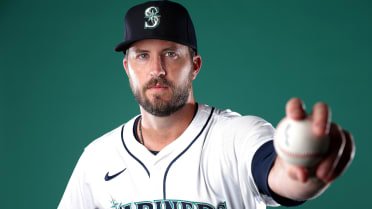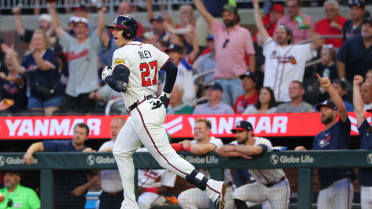This seems like the simplest change, right? From now on, when a team wants to intentionally walk a batter, the pitcher will not have to lob the four pitches outside the strike zone. Instead, the team's manager can point the runner to first base.
Simple rule. There really shouldn't be any questions.
But, of course, I have a lot of questions. A lot of questions. And I poked around and got some answers.
1. What is this again?
As you know, throughout baseball history, whenever a manager decided to intentionally walk a batter, he would have his pitcher throw four pitches out of the zone. Every once in a great while, something interesting would happen during this little game of pitch and catch -- a wild pitch, a batter reaching out and hitting the ball, a little bit of trickery with the catcher slipping back into the box -- but 99 percent of the time, it was a minute or so of boredom.
For many years, many people have sat in the stands and thought: "Why do they actually have to throw the four pitches?"
Well, the owners and players agreed to change the rule so that now pitchers don't have to throw those pitches. The manager can simply signal that he wants the batter walked, and the batter automatically goes to first base. That's pretty much the whole thing.
2. Why is MLB doing this?
Commissioner Rob Manfred leads a charge to cut dead time out of the game. Many feel baseball's pace doesn't fit the time, that it is too long and too slow to capture newer, younger fans. You will often hear this referred to as baseball's pace-of-play problem. Manfred and others would like to streamline baseball by cutting out some of the inaction. The four pitches thrown for the intentional walk were an easy target.
Nobody in baseball thinks that the new automatic intentional walk will do much to streamline the game. Nobody sees this as a cure-all ... or even a particularly bold step. Instead, it is just one among many speed-up-the-game ideas such as reducing mound visits, adjusting the strike zone, adding a pitcher's clock or cutting back on pitching changes.
So if it isn't a big idea, why do it? Because those other ideas are controversial and it is difficult to get consensus; they will take time and negotiation. This idea turned out to be fairly easy, Nobody in the game thinks it will have much of an impact. It's just a small step -- and a sign that baseball is serious about trying to cut dead time.
3. Does the manager himself have to order the walk or can the pitcher do it?
Just like with replay challenges, it is the manager who must get the attention of the umpire and signal the walk. Players cannot do it.
4. Is there a specific signal for ordering the walk?
Sadly, no, not yet. My favorite idea along these lines is to have the manager wave a white flag. Someone else suggested the universal "We're not worthy" bowing sign. I'm all for anything slightly demeaning like that, but that's because I thoroughly loathe the intentional walk.
As of right now, there is no official signal. MLB expects different managers to signal the walk any number of ways. He can come out of the dugout. He can yell across the field. He can hold up a "WALK HIM!" sign. He can walk out to the mound, talk to the pitcher and then tell the umpire on the way back to the dugout. It doesn't matter ... not until baseball starts furnishing white flags.
5. Does the manager have to order an intentional walk or can he have the pitcher throw the four pitches like before?
Nothing in the official rules has changed regarding the intentional walk itself. So if a manager wants his pitcher to throw those four intentional walk pitches -- say, to give a reliever time to warm up -- he can. No one in MLB expects this to happen much, if at all.
6. Let's say a pitcher gets behind in the count and the manager then decides to intentionally walk the hitter. Does the pitcher need to throw the last two or three balls? Or can the manager point the hitter to first base?
The manager can choose to intentionally walk a hitter on any count. So if the manager has a bad feeling -- even if the count is full -- he can get the umpire's attention and order the walk on command.
This, admittedly, feels a bit weird. It's one thing to have the manager order a walk right at the start of the at-bat. But to actually stop action and walk someone mid-at-bat, that seems more intrusive. Will a pitcher feel like he's being shown up if this happens? It's hard to say, but then it's hard to say if this will ever even happen.
7. What about Jonathan Lester?
Yes, what about him? Lester has thrown four intentional walks in his entire career. That's right: four. It is by far the lowest per-start total since they started counting intentional walks some 60 years ago.
Lester, of course, is famously uncomfortable lobbing a baseball. He almost never attempts a pickoff. Lester does not field bunts if there's any way to avoid it. He has not intentionally walked a batter since 2012.
So this leads to a fascinating question: Will Lester start using the intentional walk more often now that he doesn't have to actually throw the pitches? People in and around baseball see this rule as little more than a cosmetic change, but in the case of Lester, it could have a real on-field impact.
8. What other pitchers have thrown very few intentional walks in their career?
Glad you asked.
Fewest intentional walks per start since 1955 (minimum 1,500 innings)
- Lester, 1 per 79 starts
- Brad Radke, 1 per 31 starts
- Cliff Lee, 1 per 27 starts
- Max Scherzer, 1 per 24 starts
- Felix Hernandez, 1 per 22 starts
Yes, Lester is all alone at the top.
9. Fine, but what starters have had the most intentional walks?
Some pretty good pitchers.
Most intentional walks - Greg Maddux, 177
- Gaylord Perry, 164
- Steve Carlton, 150
- Tom Glavine, 145
- Don Drysdale, 123
10. Will this rule affect the number of intentional walks in 2017?
Nobody knows for sure, but the feeling inside baseball is that, yes, the number of intentional walks will go up slightly.
Why? Two theories. One is obvious: It's now easier for a manager to intentionally walk a hitter than ever before. All he has to do is point. Because it is easier, some people expect them to use the intentional walk a bit more often than they did before.
The second theory is interesting: Sometimes in baseball, as you know, a manager will ask a pitcher to pitch around a hitter. The pitcher will then throw four pitches out of the strike zone in the expectation of walking him. Why not just intentionally walk him? Because the pitcher hopes that the hitter will chase something out of the zone and get himself out. This is sometimes called the intentional unintentional walk.
The theory here is that because of the automatic intentional walk option, managers might stop asking pitchers to do that -- saving the four pitches and a little bit of wear-and-tear on the arm.
But, to be honest, nobody knows for sure what will happen. Even small rule changes often have unintended consequences and surprising effects. The predominant belief around baseball is that this change will be no big deal ... and that after a couple of weeks, nobody will even think about it.
MLB.com columnist Joe Posnanski is a No. 1 New York Times best-selling author, an Emmy Award-winning writer and has been awarded National Sportswriter of the Year.



